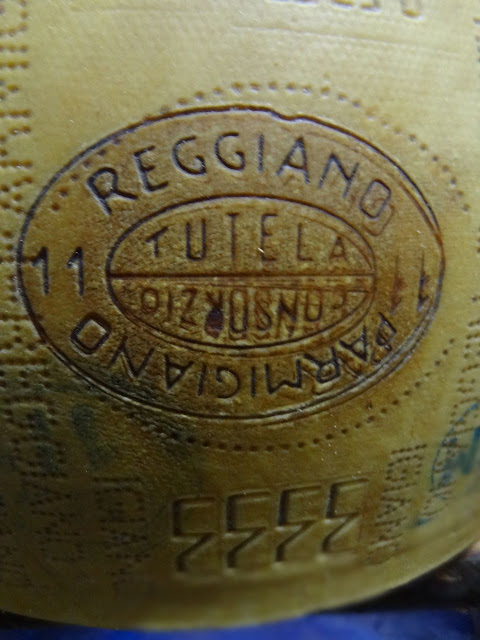The family-run Damiani Parmigiano Reggiano operation or 'caseificio',
in the countryside outside Parma
Anna Damaini, testing the consistency of one of ten vats milk,
which is brought in fresh every morning
As the milk cooks, the curdled grains sink to the bottom and the whey sits on top
The curd is dislodged from the bottom of the vat and rolled up into a large cloth...
Rolled back and forth a few times...
Then the ball is cut in half, which will make 2 wheels of Parmigiano-Reggiano
One bag with half a ball of curd is attached to the rod and hung to drain
Both bags are hung to dry as the vat is emptied of the whey,
which is later fed to pigs reared for Prosciutto Parma
Each drained bag of curd is lifted off the rods and rolled back and forth
into a more spherical shape...
one at a time...
...then placed in a plastic container to shape the final Parmigiano cheese
A heavy lid is placed overtop to weight down the 'cheese'
The 'cheese' is left to mature for a week...
Then the cheese is placed in a water bath...
,,,with salt that is added each day
The Parmigiano is left to mature for a year or two...
...at which point each and every wheel is tested by professionals
to ensure the Parmigiana adheres to DOP standards
Approved wheels get the DOP 'stamp of approval' seared into the rind
Second best are marked with horizontal stripes
Next stop was to visit the production area of Prosciutto di Parma or Parma ham, located in the southern part of Parma province. Here, and only here, can genuine Parma Ham be produced. Using very heavy and selected Italian pigs and following the traditional and genuine method, Prosciutto di Parma is still produced like it was about 2000 years ago. Only four ingredients are necessary to produce Parma ham: a pork leg, a minimum quantity of salt to preserve the meat, the air to dry it out, and time, a lot of time, at least 12 months to get a perfect flavour. We were able to visit the cooling and salting rooms before ending in the magical aging cellar.
Once the Parma ham is cured, the open end is rubbed with suigno,
a fat that protects the flesh from drying out
The hams are then left to dry
Then, like wheels of Parmigiana-Reggiano, every ham is tested by the DOP,
and seared with the 'Parma' stamp of approval
The final stop — Traditional Balsamic Vinegar of Reggio Emilia at Medici Ermete, a renowned winery and producer of fine TBV. Emilia-Romagna is the birthplace of that most delectable of vinegars: Aceto Balsamico Tradizionale di Modena. Syrupy, rich balsamic vinegar, aged in wooden barrels until it acquires the depth and complexity of a fine wine. Dubbed balsamic thanks to its curative powers, it is still fermented and aged just like it was in the Middle Ages, when only the noble classes could afford it. The prized condiment is produced directly from grape juice. The liquid is then placed in wooden barrels and through an oxidation process over several years, is transformed into the prized elixre. The tour started with a visit to the rooms where the 'black gold' is produced, aged and preserved in old French oak barrels. We were then able to taste 3 traditional balsamic vinegars which were 15, 23 and 30 years old.
The Medici Ermete Winery, where they've also been making
Aceto Balsamico Tradizionale for generations
The balsamico is stored in large French oak barrels for a few years
until it matures, at which point it's transferred to small barrels
The Aceto Balsamico is moved upstairs to the Acetaia, and into smaller casks
for the final aging for up to 40 to 50 years!
The barrels, held in an attic where the sun's rays are allowed to filter in and play their part in the vinegar's evolution, are topped up with vinegar from the next larger barrel so that they are always two-thirds full. It takes almost 800 pounds of grapes to produce 15 quarts of vinegar, which explains the high cost of genuine balsamic vinegar.
The tiny little casks of Aceto Balsamico Tradizionale are open on top with cloth covers,
allowing the makers to smell the balsamico as it ages
The final product - Aceto Balsamico Tradizionale - red, silver and gold
We ended the day with a gourmet lunch at the historic 15th-century Castello di Torrechiara, which is located just outside Langhirano, in the beautiful Emilia-Romagnan countryside.
The15th-century Castello di Torrechiara in the Langhirano Valley,
home of Prosciutto di Parma, where we had lunch
Ristorante Taverna del Castello
A nice bottle of wine was included in our meal at Torrechiara Castle
Antipasto Mista with Prosciutto Caldo, Culatello and Salumi
Tortelli di Zucca (pumpkin) e di Erbetta (spinach and ricotta)


































Very interesting, They still doing it in traditional way, But the chesse looks really good..
ReplyDeletewww.travelvisaaustralia.com